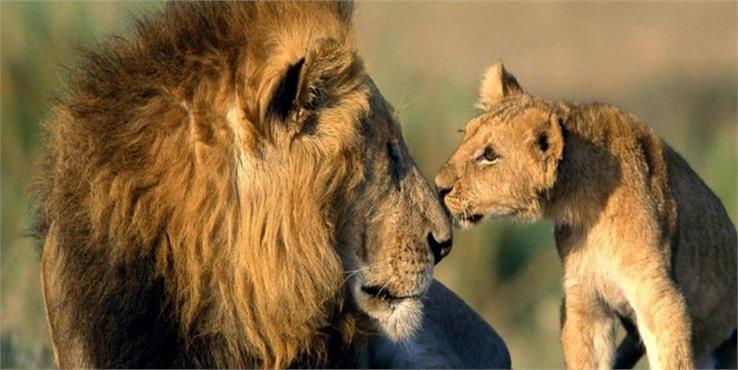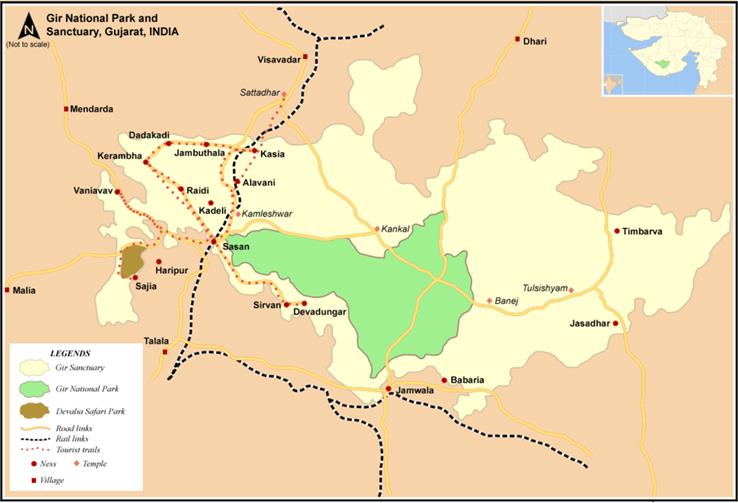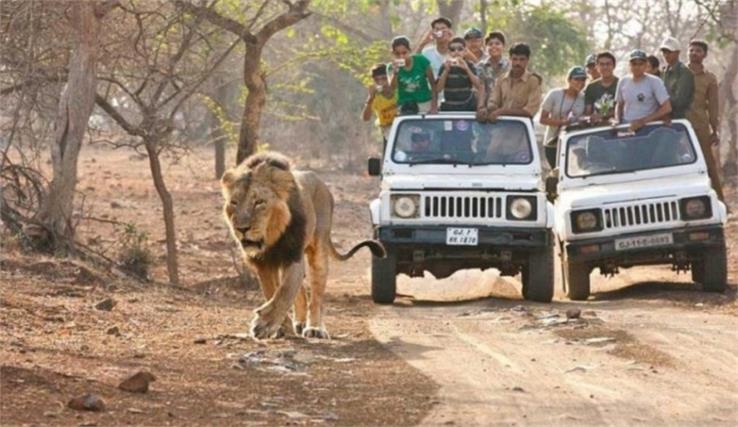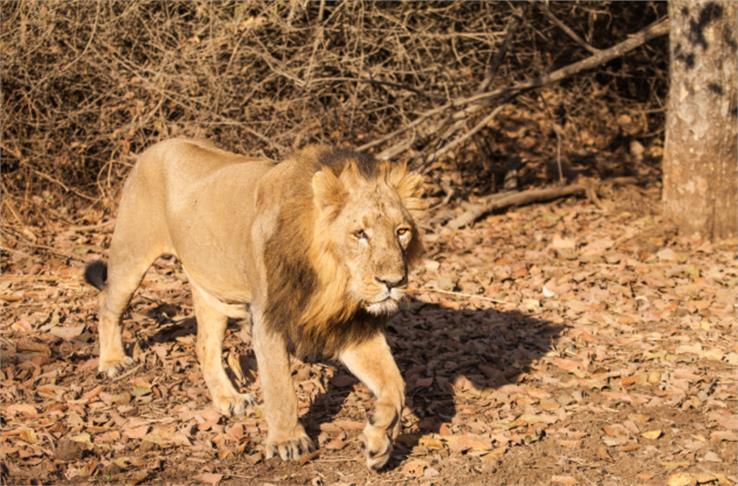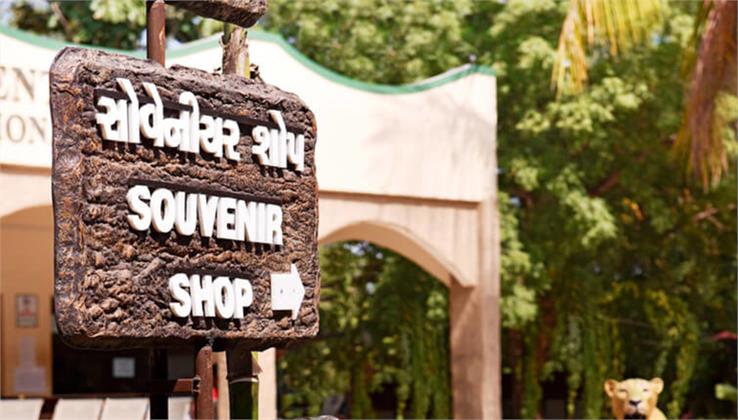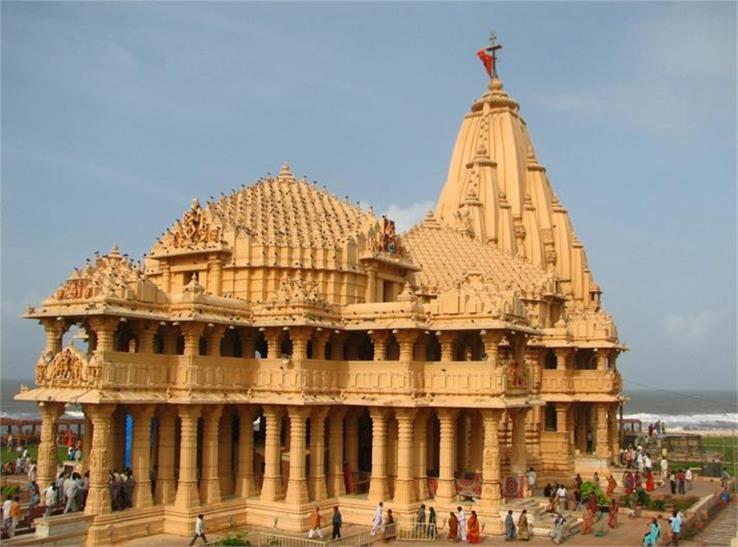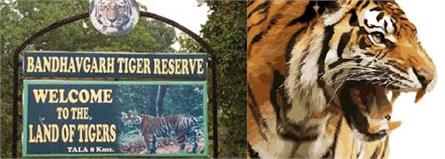Gir National Park | Location & Asiatic Lions | AlightIndia
The only natural habitat of world popular Asiatic Lions, Gir National Park is a forest and wildlife sanctuary situated in Gir Somnath district in the Gujarat state of India. It is the only space for lions to roam freely and has around 523 in number (according to 14th Asiatic Lion Census 2015). The park is also known as Sasan Gir and is an abode for most of the wildlife creatures with the great environs and topography. Established in 1965, it covers a total area of 1,412 sq. Km of which 258 sq. Km is fully sheltered as a national park and 1,153 sq. Km as a wildlife sanctuary.
In the ancient period of the 19th century, the Britishers were invited by the rulers of Indian princely states for hunting excursions. It is believed that Gir Forest, the private hunting ground of Nawab of Junagarh was left with mere dozen Asiatic lions which were the total population in the entire country. With the sharp decline in the population of lions, British Viceroy brought this crucial matter to the attention of the Nawab of Junagarh who later established the sanctuary. During 1960, the Government of India put the ban on hunting and poaching activities and several measures were taken to protect the wildlife. Today, the wildlife sanctuary is boasting more than 500 lions and has become one of the mainlands for Asiatic lions.

With the varied species of fauna, it retains 38 types of mammals, about 300 kinds of birds, 37 sorts of reptiles and more than 2,000 variety of insects. This mainly comprises the Asiatic lion, jungle cat, Golden jackal, honey badger, Indian leopards, striped hyena, Indian gray mongoose and Ruddy mongoose, rusty-spotted cats, chital, sambar, chinkara, blackbucks, nilgai, porcupine, among others. The reptiles like Indian cobra, mugger crocodiles, pythons, tortoise, monitor lizard, etc. are easily found here. Moreover, birds like endangered Bonelli's eagle, brown fish owl, rock bush-quail, brown-capped pygmy woodpecker, crested treeswift, crested serpent eagle, can be spotted in the national park.
Further, the park is a hub of more than 400 species of flora that makes it beautiful and scenic. Most of the forest area (almost half) is covered with teak trees, while other trees like banyan, amla, ber, bamboo, acacia, salia, etc. can also be spotted. The other part of the region has mostly broadleaf and evergreen trees. The forest has only River Hiran flowing throughout the year, while others being seasonal. Open scrubs and savannah-type of grasslands are also scattered around the park.
Now, it’s time to explore!
These are the following activities which you can enjoy and experience the park at its best:
-
Go on jungle expedition via Safari

Tourists can explore the Gir jungle trail through Jeep Safari and enjoy the wild sightings and green space around. Get yourself booked a jeep safari and spot lions, asses, leopard, and other wildlife which is altogether a wonderful experience.
|
Gir Jungle Trail Timings |
|
|
Morning Timings |
Evening Timings |
|
6.00 AM to 9.00 AM |
3.00 PM to 6.00 PM |
|
8.30 AM to 11.30 AM |
|
|
Gir Safari Timings |
|||
|
Vehicle Type |
Particulars |
Morning Timings |
Evening Timings |
|
Gypsy |
Monday to Sunday |
7 AM-7:55 AM |
3 PM-3:55 PM |
|
Gypsy |
Monday to Sunday |
8 AM-8:55 AM |
4 PM-4:55 PM |
|
Gypsy |
Monday to Sunday |
9 AM-9:55 AM |
5 PM-5:55 PM |
|
Gypsy |
Monday to Sunday |
10 AM-10:55 AM |
|
|
Note: Closed on every Wednesday |
|||
Jeep Safari charges are as follows:
|
Days |
Particulars |
Indian (INR) |
Foreigner (INR) |
|
Normal Day |
Up to 6 persons |
800 |
5600 |
|
Normal Day |
Extra Child |
100 |
1400 |
|
Saturday, Sunday/ Festival Days |
Up to 6 persons |
1000 |
7000 |
|
Saturday, Sunday/Festival Days |
Extra Child |
125 |
1750 |
-
Get a traditional shopping experience

Gir may not provide you with lots of shopping stuff but surely it won’t disappoint you in terms of conventional handicraft things. There are attractive locally made items which are worth taking back your home. Traditional bandhani, Ghagra-cholis, wall hangings, cradle clothes, and yes, the pride of Gujarat Patola silk sarees are some delightful items you can shop. There are several stalls available on the Entry-Exit gate offering souvenirs, handmade products, and much more.
-
Take part in Tribal festivals
Gir has mainly two kinds of tribes which are Siddis and Maldharis and they organize various festivals and fairs to celebrate and have fun. This is the time when visitors can also mingle with their folk and spend a gala time with the tribe. Various feasts like Chitra Vichitra fair, food fairs, Dang Darbar (celebrated a few days before Holi), etc. are few events which are not to be missed and surely increase your cultural awareness.
What’s more to explore?
Besides Gir National Park, there are several other beautiful places to see around which are worth visiting.
Somnath Temple

One of the oldest and most famous Hindu pilgrimage sites, Somnath Temple is deemed to be the first among the twelve jyotirlinga shrines of Shiva in India. The Chalukyas style architecture makes this temple very beautiful which is located at just around 65 Km from the park.
Kamleshwar Dam

Located within the park, the Kamleshwar Dam or Hiran-I Dam is a rock-fill embankment dam built over Hiran River. It is the resting place of a large number of bird species and known for the rearing site of swamp crocodiles.
Darbar Hall Museum
Darbar Hall Museum is famous for preserving the treasures of the Junagarh rulers and possesses about 2900 artifacts. It provides opportunities to its visitors to go through historical manuscripts, archeological remains, and antics. The distance between the museum and the park is around 80 Km.
Junagadh Zoo
Junagadh Zoo, popularly known as Sakkarbaug Zoo is home to varied species of animals and birds, primarily known for lions. Located in Junagadh, it is 80 Km away from the Gir National Park and is one of the best zoos of Gujarat.
Nalsarovar Lake
An attractive getaway spot, Nalsarovar Lake is one of the three reservoirs that borders the area of Gir National Park. It is a paradise for bird watchers as it dwells a vast range of birds like a woodpecker, black-headed cuckoo, eagles, and to name a few.
The best time to visit Gir National Park
The park remains closed from 16th June to 15th October when the southwest monsoon arrives. Otherwise, the park experiences mainly three climates which are as follows: -
Summer: The summer starts around the month of March and occurs till May. Summers are quite hot and humid, plus temperatures reach the maximum of 45°C. It is the best time for photographers to capture great photos, especially near the water bodies. Cotton clothing will be suitable during this time, one should not forget to carry a hat, sunglasses, sunscreen, and drink enough water to beat the heat.
Monsoon: The monsoon falls from June to October with the temperature hovering between 25°C to 35°C. During this time, it is impossible to conduct safaris and the park also remains closed. Nevertheless, it seems like the park has got a new life due to rains and it becomes beautiful and thriving.
Winter: November to February are the months that bring mild temperatures ranges from around 8°C to 20°C. This is perhaps one of the best times to enjoy the beauty and witness wildlife due to the lush greenery and pleasant weather. Hop to this place during winters and get some incredible experiences. Warm clothes are required during this time.
How to reach here?

Gir National Park receives a large number of tourists due to its exclusivity of featuring Asiatic lions. It is easily accessible through airways, railways, and roadways routes. The nearest cities to the Gir National Park are Talala and Junagadh which has regular buses running between the two, respectively.
By Air: Keshod Airport is the nearest airport to the park which is approx. 90 Km away from the destination. Diu Airport is also located at a distance of a mere 65 Km. Other airports located in Rajkot (170 Km), Porbandar (175 Km), and Amreli (105 Km) are some alternative options to reach the park. Private cabs and taxis are easily available from these airports to commute through Gir.
By Train: The nearest railway stations to Gir National Park are Junagadh, Delvada, and Veraval at a distance of about 80 Km, 55 Km, and 72 Km, respectively. Rajkot Junction which is around 170 Km away from the park is one of the major railway stations connected from major parts of the country. Cabs and local transport are easily available to reach the destination.
By Road: Gujarat is one of the most thriving states in terms of good transportation infrastructure with an expansive road network. The state government of Gujarat provides public transport bus services at regular intervals from Junagadh, Veraval, Somnath, Dwarka, and Rajkot. Private buses, cabs, and taxis are also available according to one’s suitability.
The distance of the national park from the major cities:
- Diu – approx. 66 Km
- Junagadh – approx. 78 Km
- Veraval – approx. 79 Km
- Rajkot – approx. 170 Km
- Keshod – approx. 90 Km
- Ahmedabad – approx. 355 Km
- Mumbai – approx. 800 Km
Where to stay?
With numerous hotels, resorts, and homestays, Gir National Park has ample options for a laid-back stay within and outside its boundaries. The forest department manages two lodges, the Gir Lodge and Sinh Sadan Forest Lodge, while several private accommodation options are also present in the periphery of the Park. Some of them are:
- Gir Jungle Lodge
- Saavaj Resort in Gir
- Vanvaso Resort
- Anil Farm House
- Maneland Jungle Lodge
- Amidhara Resort
- Fern Gir Forest Resort
- Sukhsagar Gir Resort
- Gir Lion’s Paw Resort
- Gir Birding Lodge
- The Gateway Hotel
- Hotel Umang in Gir
So, are you excited to get into an enthralling expedition and make memories for life? Plan it soon, it’s totally worthy!
